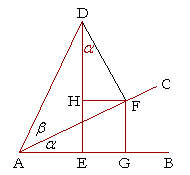
Proof of the sum formulas
| Theorem. | sin ( |
= | sin |
|
| and | ||||
| cos ( | = | cos |
||
Proof. Let the straight line AB revolve to the point C and sweep out the

angle ![]() , and let it continue to D and sweep out the angle β;
, and let it continue to D and sweep out the angle β;
draw DE perpendicular to AB.
| Then we are to determine sin ( |
ED DA |
, |
| and cos ( |
AE DA |
. |
Draw DF perpendicular to AC,
draw FG perpendicular to AB,
and draw FH perpendicular to ED.
Then angle HDF is equal to angle ![]() .
.
For, since the straight line AC crosses the parallel lines HF, AB, it makes the alternate angles equal (Theorem 8);
therefore angle HFA is equal to angle ![]() .
.
And by the construction, angle DFH is the complement of angle HFA;
therefore angle HDF (the complement of DFH) is also equal to angle ![]() .
.

Now,
| ED = GF + HD. | |||||
| Therefore, on dividing by DA, | |||||
| sin ( |
ED DA |
= | GF DA |
+ | HD DA |
| = | GF AF |
AF DA |
+ | HD FD |
FD DA |
|
| = | sin |
|||||

Next,
| EA = GA − FH. | |||||
| Therefore, | |||||
| cos ( |
EA AD |
= | GA AD |
− | FH AD |
| = | GA AF |
AF AD |
− | FH DF |
DF AD |
|
| = | cos |
|||||
This is what we wanted to prove.
The difference formulas can be proved from the sum formulas, by replacing +β with +(−β), and using these identities:
cos (−β) = cos β
sin (−β) = −sin β.
Back to Trigonometric identities
Please make a donation to keep TheMathPage online.
Even $1 will help.
Copyright © 2001-2007 Lawrence Spector
Questions or comments?
E-mail: themathpage@nyc.rr.com